cruise control VOLVO V90 2017 Owners Manual
[x] Cancel search | Manufacturer: VOLVO, Model Year: 2017, Model line: V90, Model: VOLVO V90 2017Pages: 594, PDF Size: 15.07 MB
Page 8 of 594
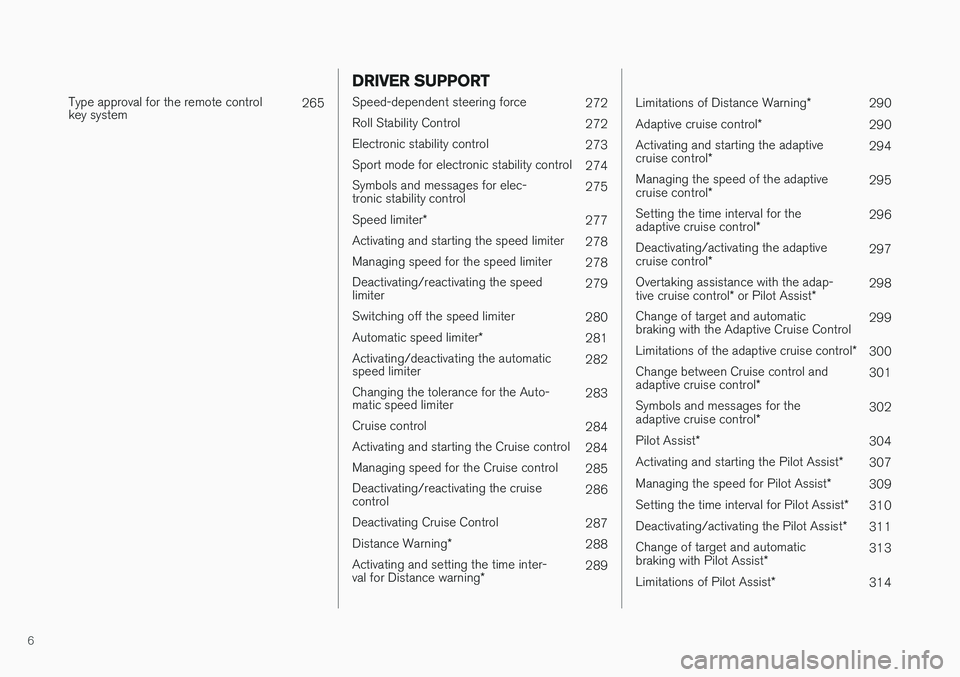
6
Type approval for the remote control key system265
DRIVER SUPPORT
Speed-dependent steering force
272
Roll Stability Control 272
Electronic stability control 273
Sport mode for electronic stability control 274
Symbols and messages for elec- tronic stability control 275
Speed limiter *
277
Activating and starting the speed limiter 278
Managing speed for the speed limiter 278
Deactivating/reactivating the speedlimiter 279
Switching off the speed limiter 280
Automatic speed limiter *
281
Activating/deactivating the automaticspeed limiter 282
Changing the tolerance for the Auto-matic speed limiter 283
Cruise control 284
Activating and starting the Cruise control 284
Managing speed for the Cruise control 285
Deactivating/reactivating the cruisecontrol 286
Deactivating Cruise Control 287
Distance Warning *
288
Activating and setting the time inter- val for Distance warning *289
Limitations of Distance Warning
*
290
Adaptive cruise control *
290
Activating and starting the adaptive cruise control * 294
Managing the speed of the adaptivecruise control * 295
Setting the time interval for theadaptive cruise control *296
Deactivating/activating the adaptivecruise control * 297
Overtaking assistance with the adap-tive cruise control * or Pilot Assist *298
Change of target and automatic braking with the Adaptive Cruise Control 299
Limitations of the adaptive cruise control *
300
Change between Cruise control and adaptive cruise control *301
Symbols and messages for theadaptive cruise control *302
Pilot Assist *
304
Activating and starting the Pilot Assist *
307
Managing the speed for Pilot Assist *
309
Setting the time interval for Pilot Assist *
310
Deactivating/activating the Pilot Assist *
311
Change of target and automaticbraking with Pilot Assist *313
Limitations of Pilot Assist *
314
Page 30 of 594
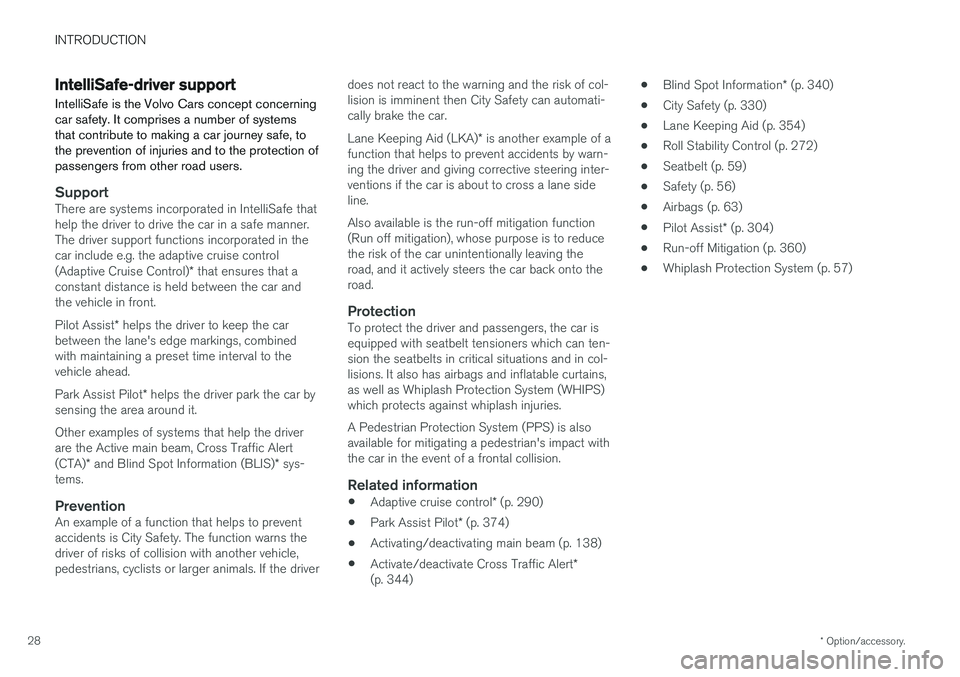
INTRODUCTION
* Option/accessory.
28
IntelliSafe-driver support
IntelliSafe is the Volvo Cars concept concerning car safety. It comprises a number of systemsthat contribute to making a car journey safe, tothe prevention of injuries and to the protection ofpassengers from other road users.
SupportThere are systems incorporated in IntelliSafe that help the driver to drive the car in a safe manner.The driver support functions incorporated in thecar include e.g. the adaptive cruise control (Adaptive Cruise Control) * that ensures that a
constant distance is held between the car and the vehicle in front. Pilot Assist * helps the driver to keep the car
between the lane's edge markings, combined with maintaining a preset time interval to thevehicle ahead. Park Assist Pilot * helps the driver park the car by
sensing the area around it. Other examples of systems that help the driver are the Active main beam, Cross Traffic Alert (CTA) * and Blind Spot Information (BLIS) * sys-
tems.
PreventionAn example of a function that helps to prevent accidents is City Safety. The function warns thedriver of risks of collision with another vehicle,pedestrians, cyclists or larger animals. If the driver does not react to the warning and the risk of col-lision is imminent then City Safety can automati-cally brake the car. Lane Keeping Aid (LKA)
* is another example of a
function that helps to prevent accidents by warn- ing the driver and giving corrective steering inter-ventions if the car is about to cross a lane sideline. Also available is the run-off mitigation function (Run off mitigation), whose purpose is to reducethe risk of the car unintentionally leaving theroad, and it actively steers the car back onto theroad.
ProtectionTo protect the driver and passengers, the car isequipped with seatbelt tensioners which can ten-sion the seatbelts in critical situations and in col-lisions. It also has airbags and inflatable curtains,as well as Whiplash Protection System (WHIPS)which protects against whiplash injuries. A Pedestrian Protection System (PPS) is also available for mitigating a pedestrian's impact withthe car in the event of a frontal collision.
Related information
• Adaptive cruise control
* (p. 290)
• Park Assist Pilot
* (p. 374)
• Activating/deactivating main beam (p. 138)
• Activate/deactivate Cross Traffic Alert
*
(p. 344) •
Blind Spot Information
* (p. 340)
• City Safety (p. 330)
• Lane Keeping Aid (p. 354)
• Roll Stability Control (p. 272)
• Seatbelt (p. 59)
• Safety (p. 56)
• Airbags (p. 63)
• Pilot Assist
* (p. 304)
• Run-off Mitigation (p. 360)
• Whiplash Protection System (p. 57)
Page 92 of 594

INSTRUMENTS AND CONTROLS
* Option/accessory.
90
Driver display
The driver display shows information about the car and driving.
The driver display contains gauges, indicators and indicator and warning symbols. The content ofthe driver display depends on the car's equip-ment, settings and which functions are active atthat time. The driver display is available in two versions, 12- inch and 8-inch.
WARNING
In the event of a fault in the driver display the information on e.g. brakes, airbags or othersafety systems may not be shown. In whichcase, the driver cannot check the status ofthe car's systems or receive current warningsand information.
WARNING
If the driver display should extinguish, not illu- minate on activation/start or be fully or parti-ally illegible, the car must not be used. Youshould visit a workshop immediately. Volvorecommends an authorised Volvo workshop.
Driver display, 12-inch
Location in the driver display:
On the left In the middleOn the right
Speedometer Indicator and warning symbols
TachometerA
Trip meter Outside temperature gauge
ECO gaugeA
Odometer ClockGear shift indicator
Cruise control and speed limiter information Messages, in some cases with graphics Drive mode Road Sign Information * Door and seatbelt information Fuel gauge
Page 94 of 594
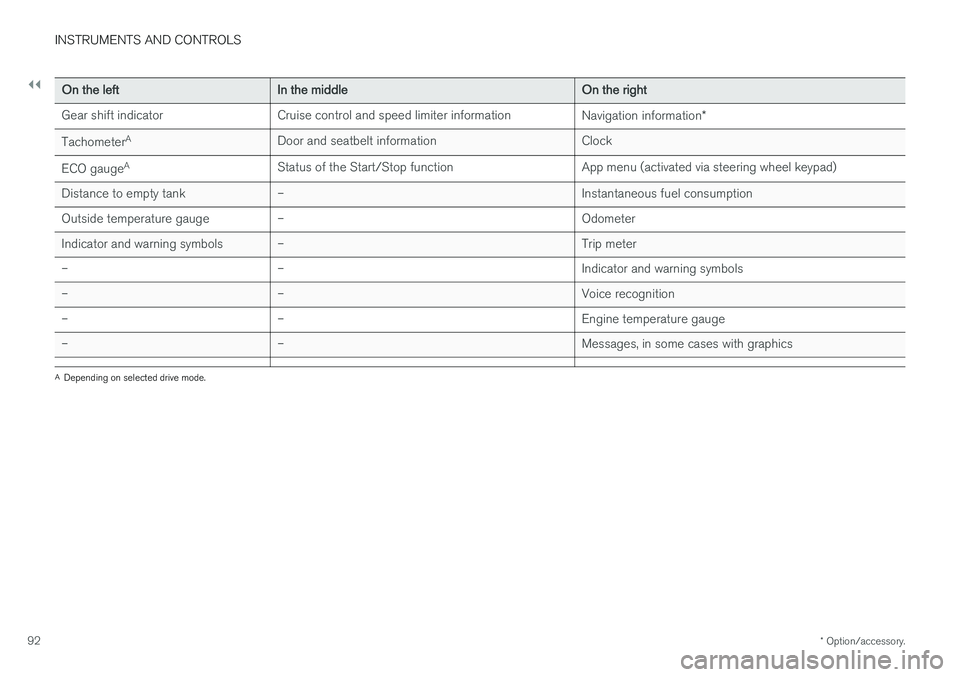
||
INSTRUMENTS AND CONTROLS
* Option/accessory.
92
On the left In the middle On the right
Gear shift indicator Cruise control and speed limiter information Navigation information*
Tachometer A
Door and seatbelt information Clock
ECO gauge A
Status of the Start/Stop function App menu (activated via steering wheel keypad)
Distance to empty tank – Instantaneous fuel consumption
Outside temperature gauge – Odometer
Indicator and warning symbols – Trip meter
– – Indicator and warning symbols
– – Voice recognition
– – Engine temperature gauge
– – Messages, in some cases with graphics
A
Depending on selected drive mode.
Page 114 of 594
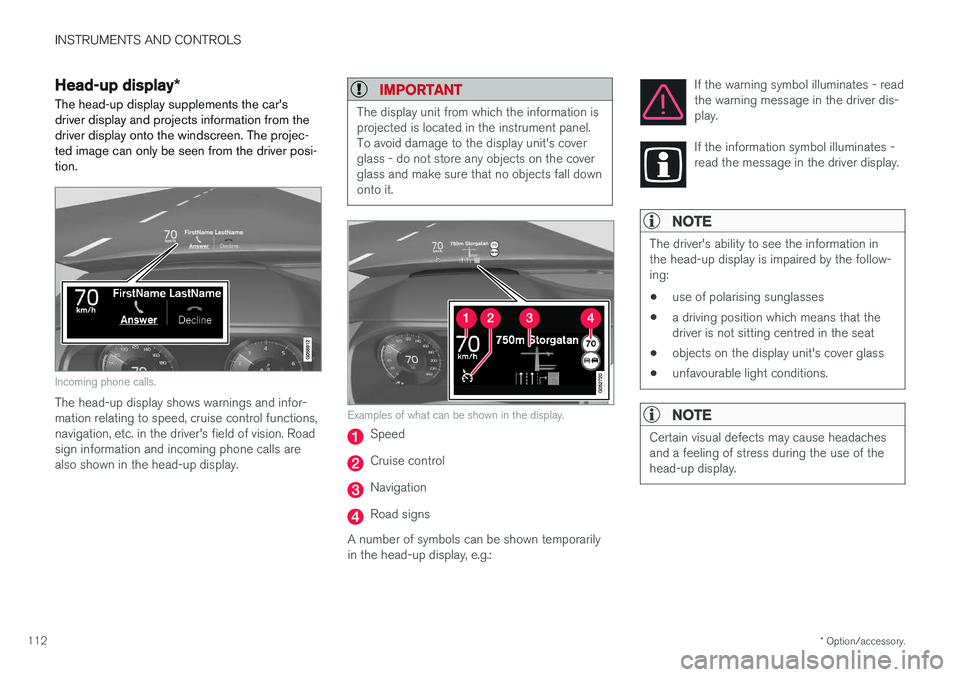
INSTRUMENTS AND CONTROLS
* Option/accessory.
112
Head-up display *
The head-up display supplements the car's driver display and projects information from thedriver display onto the windscreen. The projec-ted image can only be seen from the driver posi-tion.
Incoming phone calls.
The head-up display shows warnings and infor- mation relating to speed, cruise control functions,navigation, etc. in the driver's field of vision. Roadsign information and incoming phone calls arealso shown in the head-up display.
IMPORTANT
The display unit from which the information is projected is located in the instrument panel.To avoid damage to the display unit's coverglass - do not store any objects on the coverglass and make sure that no objects fall downonto it.
Examples of what can be shown in the display.
Speed
Cruise control
Navigation
Road signs
A number of symbols can be shown temporarily in the head-up display, e.g.: If the warning symbol illuminates - readthe warning message in the driver dis-play.
If the information symbol illuminates - read the message in the driver display.
NOTE
The driver's ability to see the information in the head-up display is impaired by the follow-ing:
• use of polarising sunglasses
• a driving position which means that thedriver is not sitting centred in the seat
• objects on the display unit's cover glass
• unfavourable light conditions.
NOTE
Certain visual defects may cause headaches and a feeling of stress during the use of thehead-up display.
Page 133 of 594
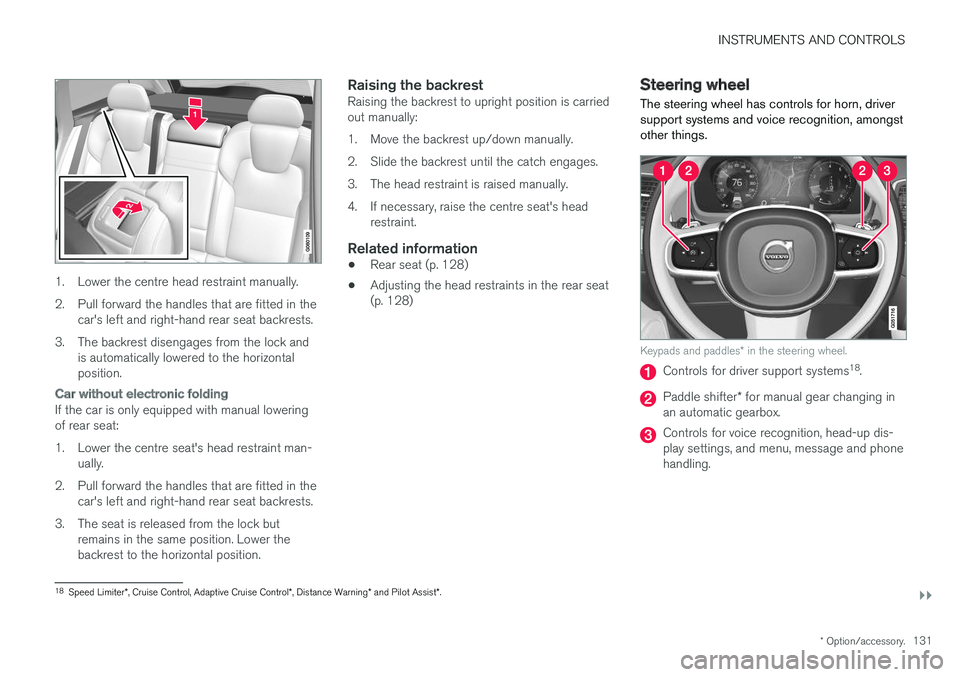
INSTRUMENTS AND CONTROLS
}}
* Option/accessory.131
1. Lower the centre head restraint manually.
2. Pull forward the handles that are fitted in the
car's left and right-hand rear seat backrests.
3. The backrest disengages from the lock and is automatically lowered to the horizontal position.
Car without electronic folding
If the car is only equipped with manual lowering of rear seat:
1. Lower the centre seat's head restraint man-ually.
2. Pull forward the handles that are fitted in the car's left and right-hand rear seat backrests.
3. The seat is released from the lock but remains in the same position. Lower the backrest to the horizontal position.
Raising the backrestRaising the backrest to upright position is carriedout manually:
1. Move the backrest up/down manually.
2. Slide the backrest until the catch engages.
3. The head restraint is raised manually.
4. If necessary, raise the centre seat's headrestraint.
Related information
• Rear seat (p. 128)
• Adjusting the head restraints in the rear seat (p. 128)
Steering wheel The steering wheel has controls for horn, driver support systems and voice recognition, amongstother things.
Keypads and paddles
* in the steering wheel.
Controls for driver support systems 18
.
Paddle shifter * for manual gear changing in
an automatic gearbox.
Controls for voice recognition, head-up dis- play settings, and menu, message and phonehandling.
18 Speed Limiter *, Cruise Control, Adaptive Cruise Control *, Distance Warning * and Pilot Assist *.
Page 134 of 594
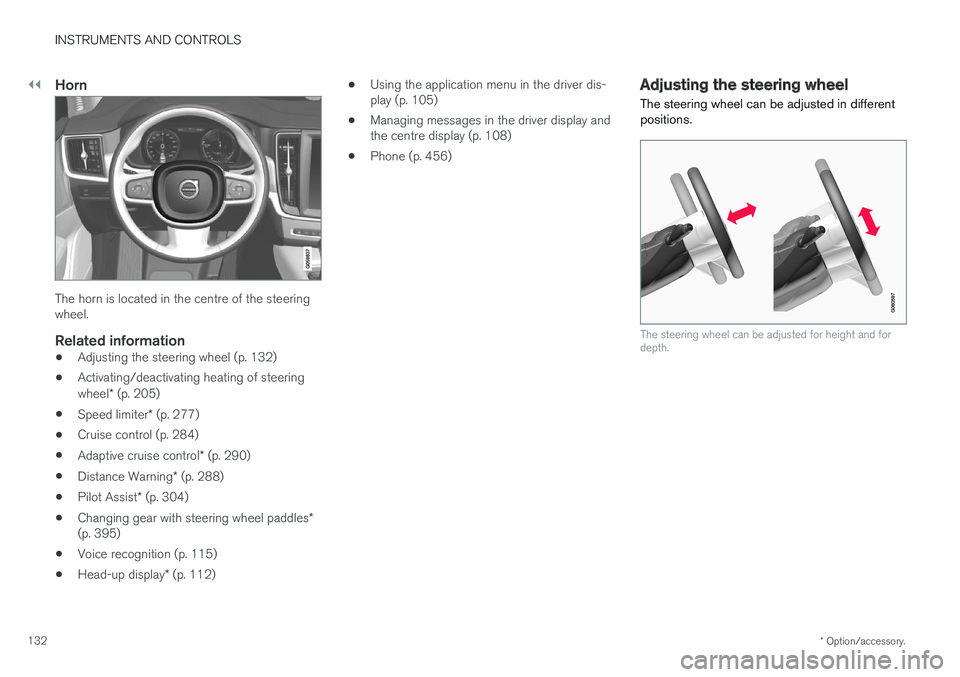
||
INSTRUMENTS AND CONTROLS
* Option/accessory.
132
Horn
The horn is located in the centre of the steering wheel.
Related information
• Adjusting the steering wheel (p. 132)
• Activating/deactivating heating of steering wheel
* (p. 205)
• Speed limiter
* (p. 277)
• Cruise control (p. 284)
• Adaptive cruise control
* (p. 290)
• Distance Warning
* (p. 288)
• Pilot Assist
* (p. 304)
• Changing gear with steering wheel paddles
*
(p. 395)
• Voice recognition (p. 115)
• Head-up display
* (p. 112) •
Using the application menu in the driver dis- play (p. 105)
• Managing messages in the driver display andthe centre display (p. 108)
• Phone (p. 456)
Adjusting the steering wheel
The steering wheel can be adjusted in different positions.
The steering wheel can be adjusted for height and for depth.
Page 145 of 594
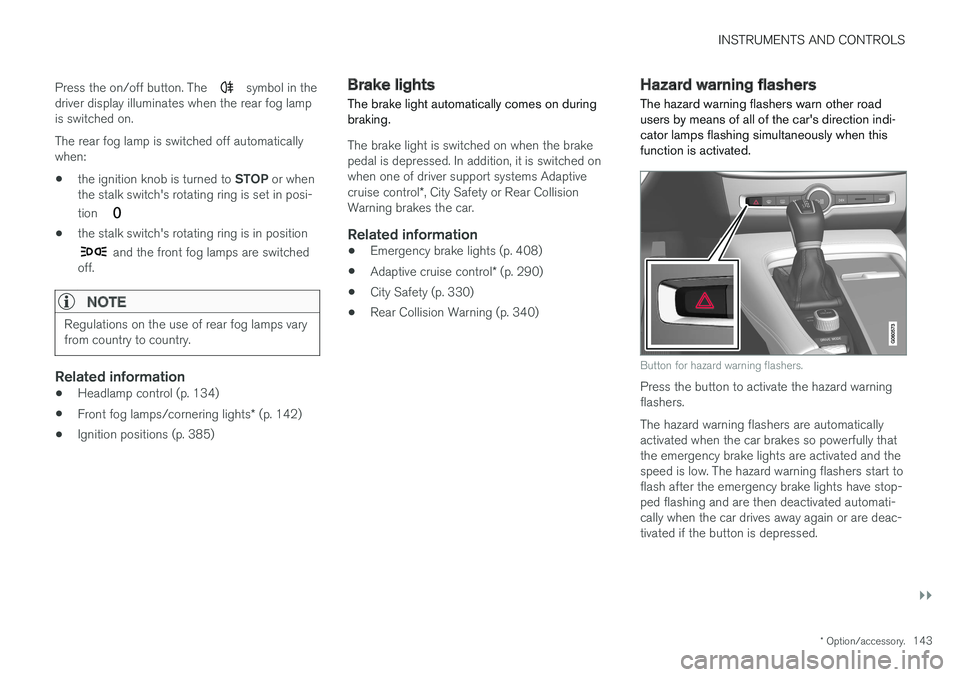
INSTRUMENTS AND CONTROLS
}}
* Option/accessory.143
Press the on/off button. The
symbol in the
driver display illuminates when the rear fog lamp is switched on. The rear fog lamp is switched off automatically when:
• the ignition knob is turned to
STOP or when
the stalk switch's rotating ring is set in posi- tion
• the stalk switch's rotating ring is in position
and the front fog lamps are switched
off.
NOTE
Regulations on the use of rear fog lamps vary from country to country.
Related information
• Headlamp control (p. 134)
• Front fog lamps/cornering lights
* (p. 142)
• Ignition positions (p. 385)
Brake lights The brake light automatically comes on during braking.
The brake light is switched on when the brake pedal is depressed. In addition, it is switched onwhen one of driver support systems Adaptive cruise control
*, City Safety or Rear Collision
Warning brakes the car.
Related information
• Emergency brake lights (p. 408)
• Adaptive cruise control
* (p. 290)
• City Safety (p. 330)
• Rear Collision Warning (p. 340)
Hazard warning flashers
The hazard warning flashers warn other road users by means of all of the car's direction indi-cator lamps flashing simultaneously when thisfunction is activated.
Button for hazard warning flashers.
Press the button to activate the hazard warning flashers. The hazard warning flashers are automatically activated when the car brakes so powerfully thatthe emergency brake lights are activated and thespeed is low. The hazard warning flashers start toflash after the emergency brake lights have stop-ped flashing and are then deactivated automati-cally when the car drives away again or are deac-tivated if the button is depressed.
Page 241 of 594

LOCKS AND ALARM
}}
* Option/accessory.239
Red Key - Restricted remote control key*
A Red Key enables the car owner to set limits for certain car properties. The restrictions areintended to promote safe driving of the car, e.g.when it is loaned out.
For a Red Key, it is possible to define the car's maximum speed, set speed reminders and deter-mine the loudspeaker system's maximum volume.In addition, some of the car's driver support sys-tems will always be active. Other functions of thekey are the same as those of a normal remotecontrol key. One or more Red Keys can be ordered from a Volvo dealer. A total of eleven keys with restric-tions can be programmed and used for a single car - at least one must be a normal remote con-trol key. The settings for Red Key are made by the user of the normal remote control key from the centre display's top view; go to:
SettingsSystem
Driver ProfilesRed Keys
Some of the car's driver support functions cannot be deactivated by the user of a Red Key. The restrictions are intended to act as measures to reduce the risk of accidents, thereby making itfeel safer to hand over the car to e.g. young dri-vers, valet parking or a workshop. The settingscannot be changed by the person using a RedKey.
Possible settingsThe following settings can be made to apply for aRed Key:
Speed limiter (Speed Limiter)
3
(On/Off):
• Setting interval: 50-250 km/h (30-160 mph)
• Setting during first use is 120 km/h (75 mph)
• Increments: 1 km/h (1 mph)
The driver display shows the symboland message
Red key Speed limitation cannot
be exceeded.
Speed reminder 3
(On/Off):
• Setting interval: 0-250 km/h (0-160 mph)
• Setting during first use is: 50, 70 and 90 km/h (30, 45 and 55 mph)
• Increments: 1 km/h (1 mph)
• Max. number of simultaneous reminders: 6
Muted max. volume 3
(On/Off):
• Setting at first use: On
Adaptive cruise control
*:
• Setting at first use: Longest intervals
• See the section "Adaptive cruise control" for more information
Driver support functionsThe following driver support functions will alwaysbe active for the user of a Red Key:
• Blind Spot Information (BLIS)
* - see section
"Blind Spot Information"
• Lane assistance (LDW and LKA)
* - see sec-
tion "Lane assistance"
• Distance warning
* - see section "Distance
warning"
• City Safety - see section "City Safety"
• Driver Alert Control (DAC)
* - see section
"Driver Alert Control"
• Road Sign Information
* - see section "Road
Sign Information".
3 Option, only available with Red Key.
Page 242 of 594
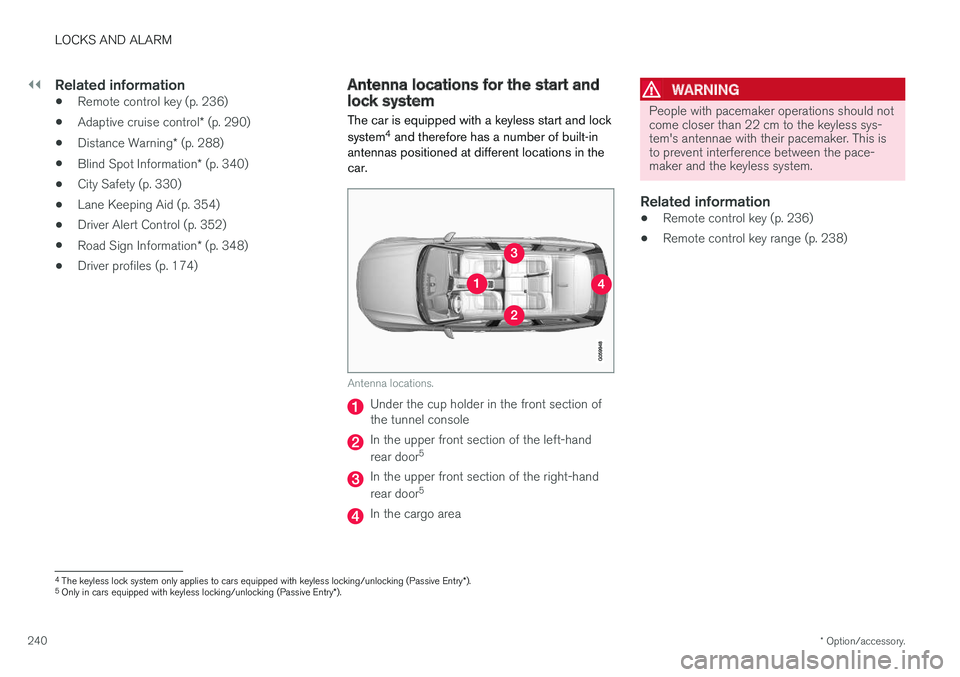
||
LOCKS AND ALARM
* Option/accessory.
240
Related information
• Remote control key (p. 236)
• Adaptive cruise control
* (p. 290)
• Distance Warning
* (p. 288)
• Blind Spot Information
* (p. 340)
• City Safety (p. 330)
• Lane Keeping Aid (p. 354)
• Driver Alert Control (p. 352)
• Road Sign Information
* (p. 348)
• Driver profiles (p. 174)
Antenna locations for the start and lock system
The car is equipped with a keyless start and lock system 4
and therefore has a number of built-in
antennas positioned at different locations in the car.
Antenna locations.
Under the cup holder in the front section of the tunnel console
In the upper front section of the left-hand rear door 5
In the upper front section of the right-hand rear door5
In the cargo area
WARNING
People with pacemaker operations should not come closer than 22 cm to the keyless sys-tem's antennae with their pacemaker. This isto prevent interference between the pace-maker and the keyless system.
Related information
•
Remote control key (p. 236)
• Remote control key range (p. 238)
4
The keyless lock system only applies to cars equipped with keyless locking/unlocking (Passive Entry *).
5 Only in cars equipped with keyless locking/unlocking (Passive Entry *).